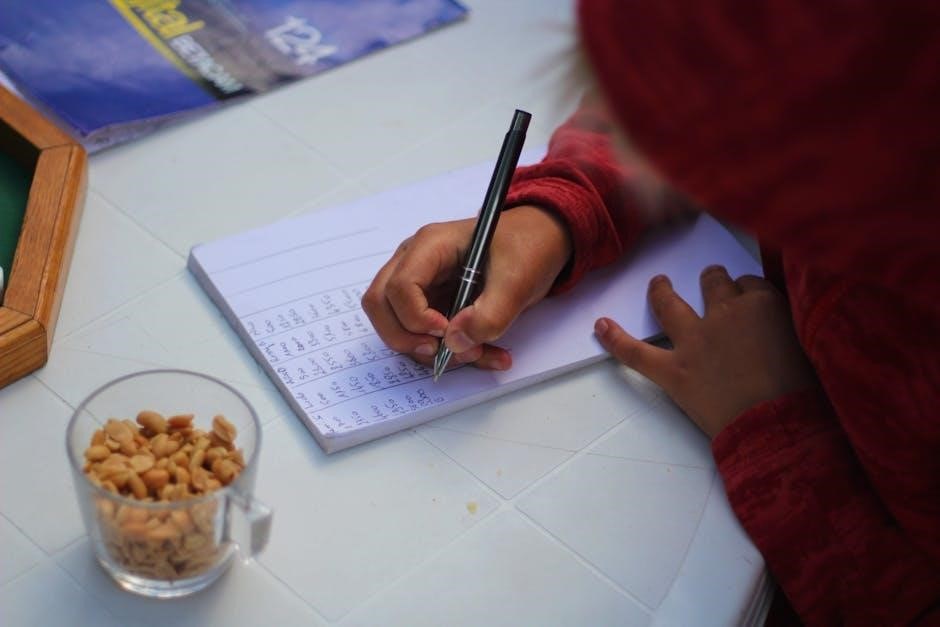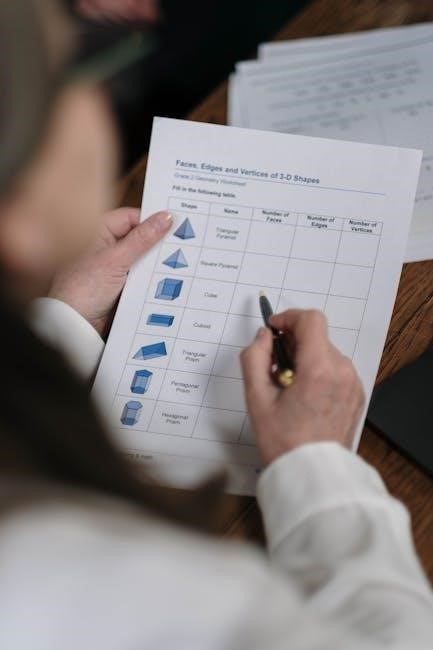
touch math addition worksheets pdf
Touch Math addition worksheets, often available as PDF downloads, utilize a unique visual strategy. They help students learn addition by connecting numbers to physical touch points, fostering mental math skills and confidence.
What is Touch Math?
Touch Math is a multi-sensory program designed to build a strong foundation in math facts. It uniquely employs the use of touch points – dots arranged in specific patterns corresponding to each number. These patterns are visually represented on addition worksheets, often in PDF format, allowing students to physically count and visualize the addition process.

This method caters to diverse learning styles, particularly benefiting kinesthetic learners. By actively touching and counting the dots, students internalize number relationships and develop fluency in addition. The program aims to transition students from reliance on the touch points to mental math strategies over time, building confidence and accuracy.
Benefits of Using Touch Math for Addition
Utilizing Touch Math addition worksheets, frequently found as PDF printables, offers numerous advantages. The visual and tactile nature of touch points supports diverse learners, making addition more accessible. Students develop a concrete understanding of number combinations, reducing reliance on rote memorization.
PDF worksheets allow for convenient practice at home or school. The method fosters confidence as students experience success with each problem. Touch Math promotes a deeper conceptual understanding, paving the way for more complex math skills. It also aids in building mental math abilities, as students gradually internalize the touch point patterns and transition to abstract thinking.

Understanding the Touch Math Method
Touch Math employs a visual strategy using PDF worksheets. It connects numbers to corresponding touch points, aiding in number recognition and building foundational addition skills.
The Core Principle: Using Touch Points
Touch points are the fundamental building blocks of the Touch Math method, prominently featured in PDF worksheets. These dots, arranged to visually represent each number, allow students to ‘touch’ and count, directly linking concrete action to abstract mathematical concepts.
This tactile approach is especially beneficial for learners who thrive with visual and kinesthetic learning styles. Instead of memorizing facts, students actively engage with the numbers, fostering a deeper understanding of addition. The arrangement of touch points mirrors the number itself – for example, the number 3 has three dots.
By physically touching each dot while counting, students internalize the quantity represented, making addition problems more accessible and less daunting. This method aims to transition students towards mental math, but initially relies on this visual and tactile support.
How Touch Points Represent Numbers
Within Touch Math addition worksheets (often in PDF format), numbers aren’t just symbols; they’re visually embodied by touch points. Each number is represented by a corresponding arrangement of dots. For instance, the number ‘1’ has one dot, ‘2’ has two, and so on, up to ‘5’ which typically utilizes a standard dice pattern.
Numbers greater than five employ a unique configuration – a combination of a five-dot pattern and additional single dots. This consistent structure allows students to quickly recognize and quantify larger numbers. The touch points aren’t randomly placed; they’re strategically arranged for easy subitizing – the ability to instantly recognize quantity without counting.
This visual representation, integral to Touch Math, bridges the gap between abstract number concepts and concrete understanding, making addition more intuitive, especially when using printable worksheets;
Connecting Touch Points to Addition Facts
Touch Math addition worksheets, frequently found as PDF downloads, leverage touch points to build fluency in addition facts. Students physically ‘touch’ each dot as they count, creating a kinesthetic link between the visual representation and the numerical value. This tactile experience reinforces the concept of combining quantities.
For example, to solve 3 + 2, a student would touch the three dots representing ‘3’, then touch the two dots representing ‘2’, and finally count all the touched dots to arrive at the answer, ‘5’. This method moves beyond rote memorization, fostering a deeper understanding of addition as combining sets.
Repeated practice with these worksheets solidifies this connection, gradually transitioning students towards mental math strategies, while still retaining the visual support of touch points when needed.

Types of Touch Math Addition Worksheets (PDF)
Touch Math addition worksheets in PDF format cater to diverse skill levels. Options range from beginner sets (adding 1-5) to advanced challenges (adding 11-20).
Worksheets for Beginners: Adding 1-5
Touch Math addition worksheets designed for beginners focus on mastering sums within 5. These PDF resources typically present simple addition problems alongside corresponding touch point images. Students visually count the touch points for each number and combine them to determine the total.
Worksheets often start with adding 1 to numbers 0-4, progressing to adding 2, 3, 4, and finally 5. The visual support is crucial for building a foundational understanding of addition concepts. These introductory exercises help children connect concrete representations with abstract numerical values.
Repetitive practice with these worksheets reinforces number recognition and counting skills, preparing students for more complex addition problems. The goal is to establish a strong base for future mathematical success.
Worksheets for Intermediate Learners: Adding 6-10
Touch Math addition worksheets for intermediate learners, available as PDF downloads, build upon the foundational skills learned with numbers 1-5. These worksheets introduce addition problems with sums ranging from 6 to 10, continuing to utilize the touch point method. Students now work with larger quantities, requiring them to combine more touch points to find the total.
Worksheets at this level often incorporate a mix of problems, including adding a number between 6-10 to a smaller number, and combining two numbers within the 6-10 range. The visual aid of touch points remains essential, supporting students as they transition towards memorizing basic addition facts.
These exercises encourage students to develop fluency and accuracy in addition, preparing them for more advanced mathematical concepts.
Worksheets for Advanced Learners: Adding 11-20
Touch Math addition worksheets designed for advanced learners, typically found as PDF resources, focus on addition problems with sums between 11 and 20. While still employing the touch point strategy, these worksheets challenge students to manage larger numbers and more complex calculations. The touch points become a tool for organizing and visualizing the addition process, rather than solely counting individual units.
These worksheets often include problems requiring students to “make ten” – a crucial skill for mental math. Students decompose numbers to create a ten and then add the remaining units. This builds a strong foundation for understanding place value and more advanced addition strategies.
The goal is to transition students from relying heavily on touch points to internalizing addition facts and performing calculations mentally.

Finding and Accessing Touch Math Addition Worksheets
Touch Math addition worksheets in PDF format are readily available online, both through free printable resources and paid options offering comprehensive bundles and varied exercises.
Free Printable Worksheets Online
Numerous websites offer free printable Touch Math addition worksheets in PDF format, providing accessible resources for educators and parents. These typically cover basic addition facts, starting with adding 1-5 and progressing to larger numbers. A quick online search reveals a wealth of options, often categorized by skill level.
These free resources are excellent for supplemental practice, homework assignments, or reinforcing concepts taught in the classroom. Many sites allow you to download and print individual worksheets or entire sets. While the quality and variety may differ, they provide a cost-effective way to introduce or practice the Touch Math method. Remember to preview the worksheets to ensure they align with your student’s current learning objectives and skill level. Utilizing these PDFs can significantly aid in building a strong foundation in addition.
Paid Worksheet Resources and Bundles
While many free Touch Math addition worksheets (in PDF format) are available, paid resources often offer more comprehensive and structured learning experiences. Platforms like Teachers Pay Teachers host a variety of Touch Math bundles created by educators, providing extensive practice and differentiated instruction.
These paid resources frequently include answer keys, progress monitoring tools, and worksheets targeting specific skills. Bundles may cover a wider range of addition problems, including multi-digit addition and word problems. Investing in paid resources can save time and ensure a more thorough curriculum. They often feature higher-quality graphics and more engaging activities, enhancing student motivation. Consider these options for a more robust and organized Touch Math learning journey, delivered conveniently as PDF downloads.
PDF Format Advantages for Printing and Sharing
Touch Math addition worksheets in PDF format offer significant advantages for educators and parents. PDFs ensure consistent formatting across different devices and operating systems, preserving the visual layout crucial for the Touch Math method. This consistency is vital for students learning to recognize and utilize touch points effectively.
PDFs are easily printable, allowing for tangible practice and offline learning. They are also readily shareable via email or online learning platforms, facilitating collaboration between teachers, parents, and students. The universal compatibility of PDFs eliminates concerns about software requirements or file corruption. Furthermore, PDFs are generally secure and prevent unintended modifications, ensuring the integrity of the addition practice materials. This makes PDFs an ideal choice for distributing and utilizing Touch Math resources.

Implementing Touch Math Worksheets Effectively
Touch Math addition worksheets (PDF) thrive in positive environments. Introduce touch points slowly, adapting materials to suit diverse learning styles for optimal student success.
Creating a Positive Learning Environment
Touch Math addition worksheets (PDF) are most effective when integrated into a supportive and encouraging classroom atmosphere. Foster a space where students feel comfortable taking risks and exploring mathematical concepts without fear of judgment. Celebrate effort and progress, not just correct answers.
Encourage peer collaboration and allow students to explain their reasoning using touch points. This reinforces understanding and builds confidence. A positive environment minimizes anxiety and maximizes engagement with the worksheets.
Remember to provide individualized support and adjust the pace to meet the needs of each learner. Consistent positive reinforcement will help students develop a strong foundation in addition and a positive attitude towards math.
Tips for Introducing Touch Points to Students
When first introducing Touch Math addition worksheets (PDF), begin with concrete examples. Demonstrate how each number corresponds to a specific number of touch points. Start with smaller numbers (1-5) to avoid overwhelming students. Emphasize counting the touch points to find the total, linking the visual representation to the addition fact.
Encourage students to physically touch the points on the worksheets as they count. Model the process aloud, verbalizing each step. Gradually transition from physical touching to visually counting the points.
Use manipulatives alongside the worksheets to reinforce the concept. Consistent practice and positive reinforcement are key to mastering this method.
Adapting Worksheets for Different Learning Styles
Touch Math addition worksheets (PDF) offer flexibility for diverse learners. For visual learners, highlight or color the touch points to emphasize the counting process. Kinesthetic learners benefit from physically manipulating objects alongside the worksheets, representing the numbers and addition problems.
Auditory learners can verbalize the addition facts as they count the touch points. For students needing extra support, reduce the number of problems per worksheet or provide pre-filled touch point templates.
Challenge advanced learners by asking them to create their own addition problems and corresponding touch point representations. Consider using digital Touch Math resources for interactive learning experiences.

Troubleshooting Common Issues
Touch Math addition worksheets (PDF) can present challenges. Students may struggle recognizing touch points or transitioning to mental math. Address errors with patient re-teaching.
Students Struggling with Touch Point Recognition
Touch Math addition worksheets (PDF) can initially confuse students unfamiliar with the touch point system. If a child struggles identifying the dots representing each number, begin with focused practice. Isolate worksheets with smaller numbers (1-5) and verbally reinforce the connection between the quantity and the corresponding touch points.
Encourage physically touching each dot while counting aloud. Use manipulatives like counters alongside the worksheet to build a concrete understanding. Break down the process: “This number has two touch points, so we’re adding two.” Consistent, patient repetition is key. Consider creating personalized worksheets with fewer touch points initially, gradually increasing complexity as confidence grows. Remember to celebrate small victories!
Difficulty Transitioning from Touch Points to Mental Math
A common challenge with Touch Math addition worksheets (PDF) is students becoming overly reliant on the touch points. To foster mental math skills, gradually fade the visual support. Begin by encouraging students to say the number represented by the touch points before counting them. Then, prompt them to visualize the dots in their mind while solving problems.
Introduce timed practice where students solve simple addition facts both with and without the touch points. Worksheets can be modified by lightly shading the dots, making them less prominent. Focus on building fact fluency through games and activities. The goal is to internalize the addition facts so the touch points become a supportive tool, not a necessity.
Addressing Errors in Addition Problems
When students make mistakes on Touch Math addition worksheets (PDF), careful error analysis is crucial. Don’t simply correct the answer; identify the source of the error. Is it a misunderstanding of the touch point concept, a counting mistake, or a lack of fact fluency? Encourage students to show their work – circling the touch points they counted for each number.
Review the problem together, re-emphasizing the connection between the touch points and the quantities they represent. Use manipulatives alongside the worksheet for concrete reinforcement. For consistent errors, provide targeted practice on specific addition facts. Positive reinforcement and a growth mindset are key – frame mistakes as learning opportunities.

Touch Math and Technology
Touch Math extends beyond PDF worksheets! Digital resources and apps offer interactive practice, reinforcing addition skills with engaging, touchscreen-compatible activities for tablets.
Digital Touch Math Resources

Digital Touch Math resources complement traditional PDF worksheets, offering a dynamic learning experience. Several websites and educational platforms provide interactive addition exercises that mirror the touch point method. These platforms often feature gamified lessons, progress tracking, and customizable practice sets, catering to individual student needs.
Interactive whiteboards also integrate seamlessly with Touch Math concepts, allowing teachers to demonstrate addition problems visually and engage the entire class. Furthermore, some software programs allow students to digitally “touch” points on the screen, reinforcing the core principle of the method. These digital tools enhance understanding and provide immediate feedback, accelerating learning beyond static worksheets.
Using Touch Math Apps on Tablets
Touch Math apps designed for tablets provide a portable and engaging way to practice addition skills, extending learning beyond traditional PDF worksheets. These apps often feature interactive touch point exercises, allowing students to directly manipulate the visual representations of numbers. Many apps offer personalized learning paths, adapting to each student’s pace and skill level.
The tablet format is particularly beneficial as it mimics the physical act of touching and counting, reinforcing the core Touch Math methodology. Gamified elements, such as rewards and challenges, further motivate students. These apps frequently include progress reports for teachers and parents, offering insights into student performance and areas needing improvement, supplementing the use of printable worksheets.

Resources and Further Learning
Touch Math’s official website and various educational blogs offer extensive support. Explore forums for shared insights and discover additional PDF addition worksheets.
Official Touch Math Website
Touch Math’s official website (touchmath.com) serves as a central hub for all things related to their innovative instructional approach. Here, educators and parents can find a wealth of resources directly supporting the use of Touch Math addition worksheets, including detailed explanations of the methodology and downloadable PDF samples.
The site provides comprehensive training materials for teachers looking to implement Touch Math effectively in their classrooms. You’ll discover information on professional development opportunities, curriculum guides, and strategies for differentiating instruction to meet diverse learner needs. Furthermore, the official website often features updated information on new worksheets and supplemental materials designed to reinforce addition concepts. Access to a community forum allows for collaboration and sharing of best practices among Touch Math users, fostering a supportive learning environment.
Educational Blogs and Forums
Numerous educational blogs and online forums offer valuable insights and shared experiences regarding Touch Math addition worksheets. These platforms frequently host discussions where teachers exchange tips on effectively utilizing PDF resources, adapting worksheets for individual student needs, and troubleshooting common challenges.
Many blogs feature printable Touch Math activities and links to free PDF worksheets curated from various sources. Forums provide a space to ask questions, receive peer support, and discover innovative ways to integrate Touch Math into lesson plans. Searching for keywords like “Touch Math”, “addition strategies”, or “visual learning” will yield relevant discussions and resources. These communities often share success stories and practical advice, enriching the learning experience for both educators and students.